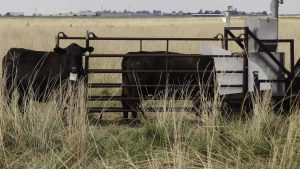
The extreme heat that’s been blanketing large parts of the country is creating conditions that could accelerate the spread of avian flu on dairy and poultry farms.
Why it matters: 100-plus-degree temperatures are making it it harder for farms to follow safety precautions for containing the H5N1 virus — especially while culling large flocks of sick birds.
- And a preliminary analysis of DNA from an infected poultry worker in Colorado indicates that the virus infecting a flock of nearly 2 million chickens there is similar to the type sickening dairy cattle in 13 states — a sign the flu may have been transmitted by people and equipment.
Driving the news: Public health officials have been urging farms to follow strong biosecurity practices and even provided protective gear from the Strategic National Stockpile to help protect workers and contain the flu.
- But that was particularly difficult during a poultry outbreak in northern Colorado, where about 160 workers had to wear Tyvek suits, respirators, goggles, boots and gloves while culling the birds as temperatures soared as high as 104 degrees.
- The scorching conditions and the industrial fans brought in to help cool the workers made it difficult to maintain an adequate seal for their masks or eye protection.
- Compounding that was the fact the fans circulated feathers and other debris known to contain the virus, said Nirav Shah, principal deputy director with the Centers for Disease Control and Prevention, during a call with reporters Tuesday.
- As many as 60 workers developed symptoms and were tested.
- Four confirmed cases and one presumptive case were identified at the farm, it was announced over the weekend. Most of the workers had mild symptoms of pink eye or respiratory illness.
The CDC is continuing to investigate the outbreak and isn’t recommending farm workers be vaccinated against the flu.
- “That’s a trade-off that always exists with PPE — balancing the need to maintain safety with the need to maintain safety, in this case, safety from the virus as well as safety from the extreme heat conditions they were in,” Shah said.
Zoom in: Infected poultry has to be culled by asphyxiating the birds.
- It’s a “very manual, difficult, laborious process” that involves picking up the chickens and putting them on a cart that uses carbon dioxide to kill them, said Julie Gauthier of the USD’s Animal and Plant Health Inspection Service.
- Shah said the CDC deployed an industrial hygienist, or a specialist who focuses on reducing the risk of disease transmission from the environmental factors
The conditions federal officials described are common at both poultry and dairy farms, said Michael Osterholm, director of the Center for Infectious Disease Research and Policy at the University of Minnesota.
- There is a model for safely performing work in dangerously hot environments wearing protective equipment from firefighting, he pointed out.
- “On 100-degree days, firefighters fight fires. What they do, though, is they have a plan in place for a limited period of exposure, and then back out and cool down, and, you know, then send in more people,” he said.
Between the lines: As attention shifted to the spread of bird flu on dairy farms in recent months, officials have highlighted the importance of stopping the spread of the virus via contaminated equipment, shared personnel who may inadvertently carry the virus on their clothes or boots, and the transportation of animals.
- Shah said the findings in Colorado highlight other areas officials should focus on: the systematic use of PPE as well as engineering controls to reduce exposure risk.
You can now read the most important #news on #eDairyNews #Whatsapp channels!!!
🇺🇸 eDairy News INGLÊS: https://whatsapp.com/channel/0029VaKsjzGDTkJyIN6hcP1K























